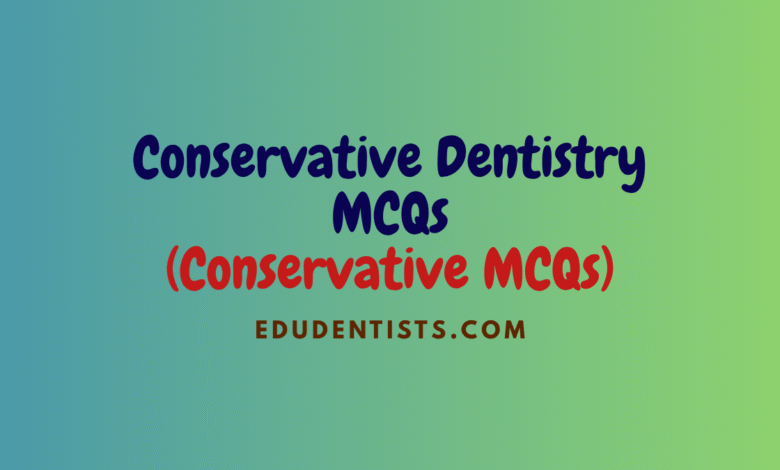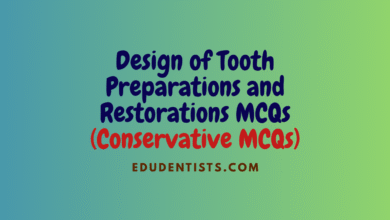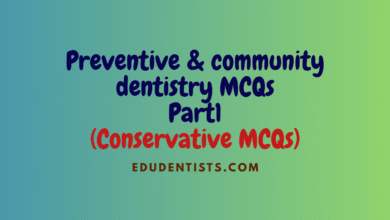Conservative Dentistry MCQs
Conservative Dentistry MCQs

Conservative Dentistry MCQs
- Which factors are important in remineralization and demineralization of early dental carious lesions:
A. Plaque composition
B. Frequency of sugar intake
C. Fluoride content of dentifrices
D. Gingival inflammation
E. Salivary flow rate - Attrition tooth wear most frequently affects which of the following tooth surfaces?
A. Buccal
B. Lingual
C. Occlusal
D. Palatal - In a case of rampant caries the ideal caries the ideal procedure to perform in the first visit is :
A. Diet control instruction
B. Topical Fluoride application
C. Gross excavation and restoration of teeth
D. None of the above. - In diet counseling to reduce caries:
A. Sugar is restricted to meal time.
B. Sugar is restricted to one time a day
C. Restricted to only liquid sugars.
D. Restricted to fibrous food. - Regarding the nursing bottle caries, All are true expect:
A. Maxillary central incisors are most affected.
B. Mandibular central incisors are least affected.
C. Pacifying sugar solutions are the cause.
D. Breast milk doesn’t cause the condition. - What is the name for the form of caries, which is rapidly progressing?
A. Rampant caries
B. Acute dental caries
C. Nursing bottle caries
D. Chronic dental caries - In cavity design classification, A class V cavity is found on ………………….?
A. The occlusal surface of a tooth
B. The interproximal surface of a tooth
C. The cervical third of the buccal or lingual surface of a tooth
D. The incisal edge of an anterior tooth
E. The fissures of a tooth. - In carious root surface lesions that have arrested, they usually:
A. Appear soft when probed.
B. Have heavily infected dentine.
C. Appear brown in color and feel hard when probed.
D. Lie close to or beneath the gingival margin.
E. Appear leathery when probed. - What type of radiograph should be prescribed when interproximal dental caries are suspected?
A. Occlusal
B. Bite-wing
C. Periapical
D. Panoramic - Using Black’s classification of cavities, what class are caries involves proximal surfaces of incisors and canines?
A. Class I
B. Class II
C. Class III
D. Class V - More prominent in older adults who have experienced gingival recession.
A. Interproximal dental decay
B.Cervical caries
C. Incisal caries
D. Generalized dental decay - Which of the following would not be suggested as an intervention for the prevention of dental caries?
A. Fluoride
B. Antibacterial therapy
C. Decreased ingestion of carbohydrates
D. Chewing mints - A caries risk assessment test is used to determine the:
A. Number of mutans streptococci and lactobacilli present in the saliva
B. Amount of fermentable carbohydrate present in the saliva
C. Level of salivary immunity
D. Salinity of the saliva - Which of the following techniques could be used for caries removal?
A. Enamel hatchet
B. Spoon excavator
C. Periodontal probe
D. A cow-horn explorer - Which microorganism must be present for caries formation to begin?
A. Staphylococcus
B. Herpes zoster
C. Candida albicans
D. Streptococcus mutans - In a carious lesion in which caries has extended into dentin, which of the following zones contains infected dentin and is not capable of remineralization?
A. Normal dentin
B. Subtransparent dentin
C. Transparent dentin
D. Turbid dentin
E. Eburnated dentin - As caries progresses from enamel to dentin and toward the pulp interproximally, the radiographic appearance resembles which of the following?
A. V shape in the enamel with the apex toward the DEJ and V shape in dentin with apex toward the pulp.
B. Vshape in enamel with apex toward the proximal surface and V shape in dentin with the apex toward the pulp, resulting in a diamond appearance.
C. V shape in enamel with the apex toward the DEJ and V shape in dentin with the apex toward the DEJ, resulting in a bowtie appearance.
D. V shape in enamel with the apex toward the proximal surface and V shape in dentin with the apex toward the DEJ. - Acute Dental caries differs from chronic dental caries, in that, there is:
A. Greater Depth than width to the lesion
B. Usually very little sensitivity
C. Much greater pigmentation of the lesion
D. Fracture of the unsupported enamel
E. All of the above - Incipient caries
A. The surface zone is relatively unaffected.
B. The surface zone is the largest portion with the highest pore volume.
C. Tooth preparation and composite is the best treatment.
D. Pulpal reaction is not possible.
E. Caries progress in enamel faster than dentin. - A deficiency of which vitamin has been associated with enamel defects and increased risk of dental caries?
A. Vitamin A
B. Folic Acid
C. Vitamin D
D. Vitamin C - What is the pH at which initiation of dental caries begin?
A. 4.3 -4.5
B. 5.2 – 5.5
C. 4-.9 – 5.1
D. 3.5 – 4.5 - Saliva helps prevent caries by:
A. Washing away plaque
B. Suppressing growth of lactobacilli
C. Diluting acids
D. Inhibiting growth of strep, mutans - In the earliest stages of the carious lesion, there is loss of:
A. Enamel Cuticle
B. Interprismatic substance
C. Organic matrix
D. Enamel lamellae - Widely accepted theory in dental caries:
A. Proteolytic theory
B. Proteolytic chelating theory
C. Acidogenic theory
D. Autoimmune theory. - Most Tooth surface affect by caries;
A. Lingual surface
B. Pit and fissure
C. Root surface
D. Proximal surface - Cost effective method to prevent dental caries:
A. Water fluoridation.
B. Fluoride toothpaste.
C. Dental health education programs.
D. Individualized oral hygiene care. - Communities with high annual population growth need education about
A. Dental caries.
B. Periodontal disease.
C. Dentofacial anomalies.
D. Dental fluorosis. - Initiation of caries by streptococcus mutans is by the production of:
A. Dextranase and soluble dextran
B. Insoluble dextan and glucosyl transferase
C. soluble dextan and glucosyl transferase
D. None of the above - Ammonia causes:
A. Increase in plaque formation
B. Increase in calculus formation
C. Decrease in plaque formation
D. Causes precipitation of salivary proteins - Pioneer bacteria in dental caries are in:
A. Enamel
B. Dentin
C. Pulp
D. Cementum - Chemico-parasitic theory of dental caries is proposed by:
A. Miller
B. G.V black
C. Gottlieb
D. Schwartz - In a caries-free individual the saliva has:
A. low buffering capacity of acids
B. Medium buffering capacity for acids
C. High buffering capacity for acids
D. Independent of buffering capacity for acids - Caries, all are true except:
A. Lactobacillus is main acusative organism in plaque
B. Smooth surface caries occur due to streptococcus mutans
C. Pit and Fissure caries can be prevented by using pit and tissue sealants
D. Fluorides help in reducing caries incidence - Initiation of dental caries depends upon:
A. Formation of large amount of acid
B. Availability of carbohydrate food
C. Viscosity of saliva
D. Localization of acid over tooth surface - Miller put forth the acidogenic theory of dental caries in the year:
A. 1890
B. 1920
C. 1924
D. 1980 - Turbid dentin in carious tooth is all EXCEPT:
A. Zone of bacterial invasion
B. Zone which can not be remineralized
C. Zone in which collagen is irreversibly denatured
D. Zone that need not be removed before restoration - Least cariogenic among these:
A. Raw starch
B. Cooked starch
C. Sucrose
D. Fructose - In the earliest stages of carious lesion. There is loss of:
A. Enamel cuticle
B. Interprismatic substance
C. Organic matrix
D. Enamel lamellae - What is the PH at which initiation of caries begin?
A. 4.3-4.5
B. 5.2-5.5
C. 4.9-5.1
D. 3.5-4.5 - The dietary carbohydrate most likely involved in etiology of dental caries in man is:
A. Glucose
B. Sucrose
C. Dextran
D. Polysaccharide - The corrct order of microscopic zones of dentinal caries starting from the D.E junction is:
A. Zone of sclerosis, decalcification zone, bacterial invasion
B. Bacterial invasion, decalcification zone, zone of sclerosis
C. Zone of sclerosis, backterial invasion, decalcification zone
D. Decalcification zone, zone of scierosis, backterial invasion - Dental caries is associated with:
A. Streptococcus agalactiae
B. Streptococcus mutans
C. Streptococcus bovis
D. Streptococcus anginosus - Which of the following is cariogenic?
A. Selenium
B. Vanadium
C. Strontium
D. Molybdenum - Starch is considered to be less cariogenic than monosaccharides and disaccharides because it?
A. Does not diffuse through plaque
B. Is rapidly hydrolysed in the mouth
C. Enhances remineralisation
D. Raises the PH in the oral cavity - Organism involved in smooth surface caries is:
(1) Streptococcus mutans
(2) Actinomyces viscosus
(3) Lactobacillus
(4) Campylobacter
A. only 1
B. only 2
C. 1 and 3
D. All of the above - The attachment of the Actinomyces species to the tooth surface is facilitated by?
A. Fimbriae
B. Cilia
C. Flagella
D. Pseudopodia - Which of the following factors in the stephan’s curve is related to the caries incidence and sugar intake?
A. Physical form of sugar
B. Frequency of sugar intake
C. Ph of Plaque
D. Quantity of sugar intake - Cavity formation in a tooth, due to dental caries is due to:
A. Destructive potential of streptococcus mutans
B. Destructive potential of lactobacillus acidophilus
C. Lateral spread of caries along DE junction and weakening of the outer covering enamel
D. Mastectomy force and unrelated to the extent of carious process - The most pronounced effect on the oral microflora of a reduction in rate of salivary flow is a:
A. Significant increase in number of oral bacteria
B. Shift towards more acidogenic microflora
C. Significant decrease in number of oral bacteria
D. Shift towards more aerobic microflora - Which of the following organisms is found in deep carious lesions rather than in incipient lesions?
A. Streptococci
B. Lactobacilli
C. Veillonella
D. Bateroides - Early invading bacteria in carious lesions are called:
A. Microcosm
B. Pioneer bacteria
C. Advancing bacteria
D. Anaerobic bacteria - The enzyme glucosyl transferase secreted by Streptococcus mutans synthesizes glucans from:
A. Glucose
B. Fructose
C. Sucrose
D. Lactose - For a bacterium to be seriously considered in the etiology of dental caries, it must:
A. Exist regularly in the dental plaque
B. Produce extracellular amylopectins
C. Be lethal for gnotobiotic animals
D. Produce intracellular dextrans - Which tooth in the permanent dentition is the most susceptible to dental caries ?
A. Maxillary 1st premolar
B. Maxillary 2nd molar
C. Mandibular 1st molar
D. Mandibular 2nd molar - Smooth surface caries is characterized by spread of caries in enamel and dentin as cones. These alignment in enamel and dentin is:
A. Base to base
B. Apex to base
C. Apex to apex
D. None of the above - Oral foci of miller’s are seen in:
A. Dental caries
B. Lichen planus
C. Herpes simplex
D. Syphilis - Bacteria responsible for initiation of caries is:
A. Actinomyces
B. Strep. mutans
C. Lactobacillus
D. Strep. viridans - S. mutans is involved in dental caries initiation Other bacteria also involved is:
A. S. Sarcinus
B. S. macae
C. S. sanguis
D. S. salivarius - Widely accepted theory of dental caries:
A. Proteolytic theory
B. Proteolytic chelation theory
C. Acidogenic theory
D. Autoimmune theory - The number of dentinal zones in dentinal caries is:
A. One
B. Two
C. Four
D. Five - In a patient with reduced salivary flow the carious incidence is:
A. More than the patient with normal salivary flow
B. less than the patient with normal salivary flow
C. unaffected
D. None of the above - The extra – cellular polysaccharide synthesized by cariogenic streptococci in the presence of excess sucrose are best described as:
A. Mucopolysaccharide
B. Dextran-like glucan
C. Glycogen – like glucan
D. Amylopectin - Lactobacilli are numerous in caious lesions because they:
A. Are the main causative agent
B. Can produce insoluble extracellular polysaccharides
C. Can attack to smooth enamel surfaces
D. Are secondary invaders



